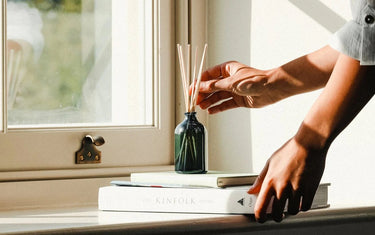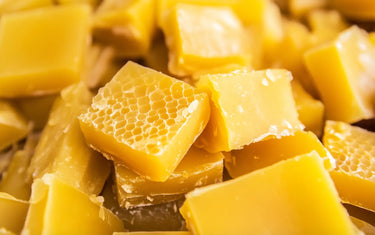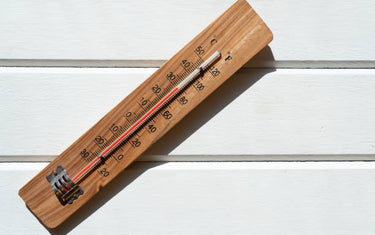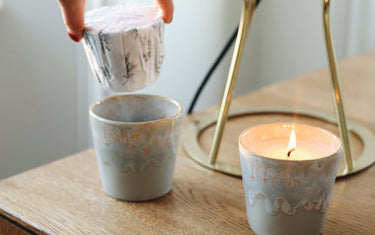5 min read / 11 July 2023 / Laura Garvin Gomez
How to Use a Reed Diffuser
Master the art of using a reed diffuser to create a blissful and fragrant ambiance in your home.
Share this post

Learning how to use a reed diffuser is quick and easy, so you won’t have to wait too long before you can start enjoying your favourite essential or fragrance oil.
It’s a completely natural process that allows you to keep the space smelling fresh without using scented candles or artificial plug-ins.
Part of the process also involves learning how to use reed diffuser sticks, which we explain below, along with pretty much everything else you need to know about getting more from your diffuser, reeds and fragrances.
Here’s a summary of how you can use them:
- Prepare the Diffuser: Protect the surface underneath by placing paper towels to catch any potential oil spills. Be mindful of the surface material to prevent permanent stains.
- Pour the Oil into the Diffuser: Fill the diffuser with essential or fragrance oil mixed with augeo or ethanol to between half and three-quarters full to prevent overflow.
- Place the Reeds: Insert the reeds into the oil, allowing them to soak briefly. Adjust the number of reeds based on desired scent strength and room size.
- Turn Over the Reeds: After a few hours, flip the reeds to expose the soaked end to the air.
- Spread Out the Reeds: Ensure the reeds are spaced apart to allow for even scent distribution. It takes about 24 hours for the reeds to fully absorb and start diffusing the fragrance.
What is a reed diffuser?
A reed diffuser uses reed sticks to absorb an essential oil or fragrance oil before releasing the scent into the air. It doesn’t require a heat source to work, so the scent can be dispersed naturally into the room for you to enjoy.
What kind of reeds can I use in a diffuser?There are a few different types of reeds you can use to absorb and release the oil, with the most popular being:
|

How to use a reed diffuser with sticks
Follow the steps below on how to use a reed diffuser with reed sticks:
- Prepare the diffuser: Before you start to use the diffuser, you should think about how you can protect the surface underneath from any potential oil spills. Pouring the oil into the diffuser hole can be a little tricky at times, given how small it is, so there’s a good chance some may miss. Place some paper towels underneath the diffuser to catch any oil that may drop off the sides. Also, consider the type of surface the diffuser will be resting on, as wooden or fabric surfaces pick up oil stains that can be difficult to remove.
- Pour the oil into the diffuser: Carefully pour the essential oil or fragrance oil mixed with augeo or ethanol into the diffuser, aiming to fill somewhere between the halfway and three-quarter mark. If the diffuser is filled right to the very top it could overflow once you place the reeds inside, so keeping the oil level down will help to avoid that happening. If you are simply refilling your diffuser, pour in the fragrance up to a point you are comfortable with.
- Place the reeds into the diffuser: Take the reeds you want to use and immerse the bottom of the sticks into the oil, giving them a little bit of time to soak it in. The more reeds you add to the diffuser, the stronger the scent will be, so consider how this will impact the size of the room you are adding a fragrance to.
- Turn over the reeds: Once the reeds have been in the oil for a couple of hours soaking up as much as they can, remove from the diffuser and flip them over. This means that the dry end of the stick should now be placed into the diffuser, with the saturated part of the stick left standing in the air.
- Spread out the reeds: Position the reeds so they are well spaced apart and not sticking together. It will take around 24-hours for the fragrance to be fully absorbed by the reeds before it can start to diffuse the scent.

How often do I have to flip the reeds in a diffuser?
To enjoy a strong, long-lasting fragrance, it is a good idea to flip the reeds over in the diffuser every one or two weeks. This will release a fresh burst of fragrance every time, whilst also helping the reeds to avoid becoming clogged up.
How many reeds should I put in a diffuser?
There is no limit on how many reeds you can put into the diffuser. You can put a few or all of them at once – it all depends how strong you want the scent to be. For smaller rooms and spaces, it is probably better to only use a small number of reeds, so the scent is not overpowering. The opposite is also true for larger rooms and spaces.
How long does it take for reed diffusers to work?
When you first place the reeds into the diffuser, you should give them 1-2 hours to soak up as much oil as possible. Flip them over and the saturation process will continue at the other end of the stick. Once this is completed, it will take about 24 hours for the fragrance to fully diffuse.
How long do reed diffusers last?
A good quality reed diffuser can last anywhere between 3-5 months, although there are several contributing factors that can affect its longevity. This includes the atmosphere in the room, where the diffuser is located, exposure to heat and cold, and more.
How often do I need to replace the reeds?
A general estimation for the lifespan of diffuser reeds is about 6 months, although they may need to be replaced before or after this time. You’ll need to start thinking about replacing the reeds if they are no longer giving off a scent, which means they may be clogged up with dust. Simply dispose of the reeds and replace them with new ones, following the same process we outlined in our step-by-step guide above.

Reed diffusers offer a natural, cost-effective way to refresh the ambience of the room. Once the sticks have absorbed the oil, they can be left to do their job and only need the occasional flip to sustain the fragrance throw. Try to protect the surface below the diffuser to avoid any messy oil spillages and when you reach the point where no fragrance is being released, simply remove, replace and enjoy all over again.









